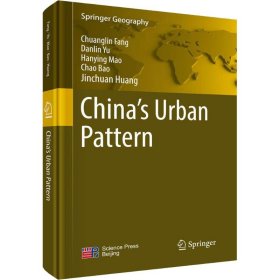
中国城市发展空间格局
全新正版 极速发货
¥ 270.27 6.8折 ¥ 398 全新
库存2件
广东广州
认证卖家担保交易快速发货售后保障
作者方创琳 等
出版社科学出版社
ISBN9787030543240
出版时间2019-02
四部分类子部>艺术>书画
装帧精装
定价398元
货号1201779105
上书时间2024-08-05
- 最新上架
商品详情
- 品相描述:全新
- 商品描述
-
目录
1 Scientific Foundations and Theoretical Systems for Optimizing the Spatial Pattern of China’s Urban Development 1
1.1 The Strategical Background and Urgency for Optimizing the Spatial Pattern of China’s Urban Development 2
1.1.1 The Macro Background for Optimizing the Spatial Pattern of Urban Development 2
1.1.2 The Strategic Significance and Urgency for Optimizing the Spatial Pattern of Urban Development 6
1.2 The Theoretical Foundations and Framework Systems for Optimizing the Spatial Pattern of China’s Urban Development 10
1.2.1 The Theoretical Foundations for Optimizing the Spatial Pattern of Urban Development 11
1.2.2 The Framework Systems for Optimizing the Spatial Pattern of Urban Development 19
1.3 The Techniques and Keys for Optimizing the Spatial Pattern of China’s Urban Development 25
1.3.1 The Techniques and Technique Contents for Optimizing the Spatial Pattern of Urban Development 25
1.3.2 The Technique Viewpoints and Pathways for Optimizing the Spatial Pattern of Urban Development 30
1.3.3 The Technique Difficulties and Keys for Optimizing the Spatial Pattern of Urban Development 33
References 36
2 The Dynamic Evolution and Moving Tracks of the Center of Gravity for the Spatial Pattern of China’s Urban Development 37
2.1 The Dynamic Evolution and Moving Tracks of the Center of Gravity for China’s Urban Size Structure 37
2.1.1 The Basic Scenarios of China’s City Administrations Prior to 1980 38
2.1.2 The Dynamic Evolution and Moving Tracks of the Center of Gravity for China’s Urban Population Since 1980 41
2.1.3 The Dynamic Evolution and Moving Tracks of the Center of Gravity for China’s Urban Economy Since 1980 48
2.1.4 The Dynamic Evolution and Moving Tracks of the Center of Gravity for China’s Urban Land Use Scale Since 1980 55
2.2 The Dynamic Evolution Tracks for China’s Urban Spatial Form and Functional Structure 62
2.2.1 The Dynamic Evolution Tracks for China’s Urban Spatial Form 63
2.2.2 The Dynamic Evolution Tracks for China’s Urban Functional Structure 68
2.3 The Stage Characteristics for the Spatial Pattern of China’s Urban Development 75
2.3.1 The Stage of Dispersed Layout and Low-Level Equilibrium Development (1949–1978) 75
2.3.2 The Stage of Concentrated Layout and Non-equilibrium Development (1979–2000) 77
2.3.3 The Stage of Networked Layout and Relative Equilibrium Development (2000–Present) 78
References 80
3 Rationality Diagnosis and Comprehensive Evaluation for the Spatial Pattern of China’s Urban Development 83
3.1 The Indicator System for Rationality Diagnosis for the Spatial Pattern of China’s Urban Development 83
3.1.1 The Basic Connotation of Rational Spatial Pattern of China’s Urban Development 84
3.1.2 The Influential Mechanisms for Rational Spatial Pattern of China’s Urban Development 85
3.1.3 The Diagnosis Indicator System for Rational Spatial Pattern of China’s Urban Development 90
3.2 Evaluating the Rationality of China’s Urban Size Structure Pattern 92
3.2.1 Rationality Diagnosis Model and Standards for China’s Urban Size Structure Pattern 93
3.2.2 Characteristics and Spatial Distribution of Current China’s Urban Size Structure 97
3.2.3 Rationality Diagnosis for China’s Urban Size Structure 107
3.3 Rationality Evaluation for China’s Urban Spatial Structure Pattern 118
3.3.1 Rationality Diagnosis Model for China’s Urban Spatial Structure Pattern 119
3.3.2 Overall Diagnosis for China’s Urban Spatial Structure Pattern 120
3.4 Rationality Diagnosis for China’s Urban Functional Structure Pattern 133
3.4.1 The UFR Rationality Diagnosis Model for China’s Urban Functional Structure Pattern 138
3.4.2 Current Distribution of China’s Urban Functional Structure Pattern 143
3.4.3 Overall Rationality Diagnosis for China’s Urban Functional Structure Pattern 155
3.5 Overall Rationality Diagnosis for China’s Urban Development Spatial Pattern 162
3.5.1 Overall Rationality Diagnosis Model for China’s Urban Development Spatial Pattern 163
3.5.2 Overall Rationality Diagnosis Results for the Spatial Pattern of China’s Urban Development 164
References 170
4 Optimization Goals and Keys for the Spatial Pattern of China’s Urban Development 173
4.1 The Principles for Optimizing the Spatial Pattern of China’s Urban Development 174
4.1.1 Principle of Fairness and Justice 174
4.1.2 Principle of Moderate Agglomeration 176
4.1.3 Principle of Coordinated Development 177
4.1.4 Principle of Innovation Driven 179
4.1.5 Principle of Sustainable Development 181
4.2 Optimization Goals for the Spatial Pattern of China’s Urban Development 182
4.2.1 Development of Urbanization Enters the Mature and Stable Stage, the Quality of Urbanization Development Improves Steadily 183
4.2.2 Urban Hierarchical Structure Becomes More Reasonable, a New Pyramid-like Organizational Pattern Gradually Comes into Being 186
……
内容摘要
《China's Urban Pattern(精)》由Chuanglin Fang、Danlin Yu、Hanying Mao、Chao Bao、Jinchuan Huang著。
The book embarks on the tasks to systcmatically analyze the macro background of the spatial patterns of China's urban developlnent, the theoretical foundations and framework, and its changing trajectory. From a quantitative perspective, we attempt to ewduate the rationale behind the spatial patterns ol:(]hina's urban development and syslematically silnulate the wuious scenarios. From the simulation results, we propose the optimizing goals, priorities, models, and strategies for the spatial patterns of China's urban development. "1 he work in this book attempts to provide constructive suggestions and potential strategies to support the effort to optimize the spatial patterns ol China's urban development. It would be a valuable reference for planning departments,development and reform commiltees, and science and technology administrative departments at various governmental levels. It could also be a valuable addition to graduate students of urban planning, urban development, urban geography and relevant disciplines.
相关推荐
— 没有更多了 —




















以下为对购买帮助不大的评价